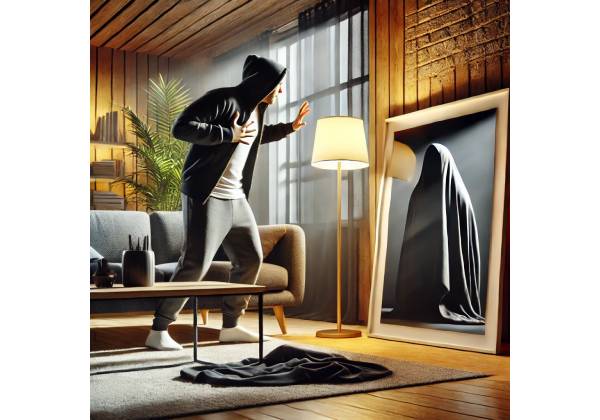What is Melanophobia?
Melanophobia is a rare and specific phobia defined by an irrational and intense fear of the color black. While many people feel uncomfortable or have negative associations with dark colors because of cultural or symbolic meanings, people with melanophobia have a persistent and overwhelming fear of the color black. This fear can be triggered by a variety of stimuli, including black clothing, objects, shadows, and dark environments.
Melanophobia sufferers may associate the color black with danger, evil, or negativity, exacerbating their anxiety. This fear is often so strong that it interferes with daily life, resulting in avoidance behaviors in which people go out of their way to avoid anything black. In more severe cases, the mere thought of the color can cause panic.
Melanophobia is more than just a personal preference or dislike. It is a serious condition classified as a specific phobia, and like other phobias, it can be debilitating. The intense fear and anxiety may impair an individual’s ability to function in social, professional, or everyday settings, especially in places where the color black is prevalent. Understanding the challenges that people with melanophobia face is critical to providing them with the necessary support and interventions to effectively manage their condition.
Common Symptoms of Melanophobia
Melanophobia can manifest in a variety of ways, impacting both the mind and the body. The symptoms are similar to those seen in other anxiety disorders and phobias, and they can differ depending on the severity of the condition. Below, we look at the various physical, emotional, and behavioral symptoms that people with melanophobia may experience.
Physical Symptoms
The physical symptoms of melanophobia frequently resemble those of a panic attack. When a person with melanophobia is exposed to the color black, their body may react as if they are being threatened, activating the “fight or flight” response. Typical physical symptoms include:
- Increased heart rate (tachycardia): When the individual sees black objects or areas, their heart may begin to race in response to the perceived danger.
- Shortness of breath or hyperventilation: Breathing may become shallow and rapid, leaving you feeling breathless. In severe cases, the person may feel like they are suffocating.
- Sweating and trembling: Severe anxiety can cause excessive sweating, especially in the palms and face. When the phobia is triggered, people may experience trembling or shaking in their hands or legs.
- Dizziness or lightheadedness: Excessive fear can cause people to feel dizzy, faint, or disoriented, especially if the encounter with black is prolonged or unexpected.
- Nausea or upset stomach: Anxiety can affect the digestive system, resulting in nausea, queasiness, or even vomiting.
- Chest tightness or pain: People suffering from melanophobia may experience a constriction in their chest, causing sharp pain or a sensation of pressure, similar to the symptoms of a heart attack.
Emotional and cognitive symptoms
Melanophobia can have a significant emotional impact because the fear of black causes persistent worry and distress. Emotional and cognitive symptoms include the following:
- Intense fear or panic: When exposed to the color black, people with melanophobia may experience intense fear or full-fledged panic attacks, which are frequently accompanied by a sense of impending disaster.
- Irrational beliefs about the color black: Many people who suffer from melanophobia form irrational beliefs or associations with the color black, such as believing it is inherently evil or dangerous. These thoughts contribute to the phobia, making the individual’s fear feel justified.
- Intrusive thoughts and anticipatory anxiety: People with melanophobia may be constantly concerned about encountering black objects or environments in the future. This persistent worry, known as anticipatory anxiety, can result in avoidance behaviors or social withdrawal.
- Feelings of helplessness or dread: Fear of black can make people feel powerless or trapped, especially if they see the color frequently in their environment.
- Overthinking or catastrophizing: People may overanalyze black-related situations, expecting the worst. For example, they may believe that being near a black object will cause harm, even though there is no rational basis for this belief.
Behavioral Symptoms
Melanophobia has a significant impact on behavior, leading to avoidance tactics and lifestyle changes motivated by a desire to escape the fear. Some behavioral symptoms are:
- Avoidance of black objects or environments: People with melanophobia may go to great lengths to avoid wearing, using, or being near black items. This can influence wardrobe choices, interior decorating, and travel plans, such as avoiding places with dark backgrounds or black-painted buildings.
- Reluctance to participate in social activities: Social events with black clothing or decor, such as formal events, parties, or even funerals, may be avoided completely. This avoidance can cause feelings of isolation.
- Difficulty at work or school: Depending on the individual’s occupation or the design of the environment, melanophobia can make attending work or school difficult. For example, working in an office with black furniture or attending a lecture in a dark theater can cause anxiety.
- Procrastination or refusal to complete tasks involving black objects: Even routine activities like handling black electronic devices, writing with black pens, or interacting with technology with dark backgrounds may be avoided or cause significant stress.
- Reliance on others to navigate black objects or environments: People with severe melanophobia may rely on family or friends to assist them in avoiding triggers, such as asking someone else to retrieve items or driving through dark areas.
Understanding these symptoms is critical to determining the severity of melanophobia and its impact on daily life. Once these symptoms are identified, individuals can begin to investigate treatment options and strategies for regaining control of their fear.
What Causes Melanophobia?Exploring the Origins and Risk Factors
Melanophobia, like other phobias, is often caused by a combination of genetic, environmental, and psychological factors. Although the exact cause varies from person to person, several potential risk factors and sources are frequently linked to the development of this phobia.
Traumatic Experiences
Melanophobia is often triggered by a traumatic experience with the color black. This could refer to an accident, a frightening situation, or a negative event that occurred in a black-dominated environment. The trauma may create an association between the color black and danger that becomes deeply ingrained in the individual’s psyche. Over time, the brain learns to perceive the color black as a threat, even in neutral or safe situations.
Learned Behavior and Conditioning
Phobias can be acquired through observation or experience, especially in childhood. If a child grows up watching a parent or sibling express fear of the color black, they may internalize that fear. Similarly, if a negative event occurred involving black objects or settings, the brain can associate black with fear using a technique known as classical conditioning.
For example, if a child was involved in a car accident in the dark or in a black vehicle, they may develop a dislike for the color black, even if the color was not the source of the trauma. If this learned behavior is not addressed, it may persist into adulthood.
Cultural and Symbolic Associations
Melanophobia can also be influenced by cultural and symbolic associations with the color black. In many cultures, black symbolizes mourning, death, evil, or the unknown. While these associations do not cause phobias on their own, they can exacerbate negative feelings toward the color. Individuals who are especially sensitive to cultural symbolism may be more likely to develop melanophobia.
Genetic Predisposition
There is some evidence that phobias may have a genetic basis. Individuals with a family history of anxiety disorders or specific phobias may be more predisposed to developing melanophobia themselves. While genetics do not cause phobias, they can predispose people to anxiety or fear-based responses, particularly when combined with environmental triggers.
Anxiety Disorders
People who have pre-existing anxiety disorders, such as generalized anxiety disorder (GAD) or panic disorder, may be more likely to develop melanophobia. The increased anxiety and worry caused by these conditions can cause an individual to focus on specific stimuli, such as the color black, and develop a disproportionate fear response.
Understanding the underlying causes of melanophobia is critical for treating it effectively. Once the underlying cause is identified, treatment can focus on desensitizing the person to the fear and assisting them in developing healthier associations with the color black.
How Is Melanophobia Diagnosed?
Melanophobia is typically diagnosed by a licensed mental health professional, such as a psychologist or psychiatrist. The process consists of several steps to ensure an accurate diagnosis and rule out other conditions that may present with similar symptoms.
Clinical Interview and Symptom Assessment
The first step in diagnosing melanophobia is to conduct a thorough clinical interview. During this session, the clinician will inquire about the individual’s fear of black, including when the fear started, how it affects their daily life, and any situations in which the fear is triggered. The clinician may also inquire about the individual’s previous experiences, including any traumatic events or childhood memories associated with the color black.
Diagnostic Criteria
Melanophobia, like other specific phobias, is diagnosed using the criteria set out in the Diagnostic and Statistical Manual of Mental Disorders (DSM-5). To meet the criteria for a specific phobia, the individual must encounter:
- Fear or anxiety over a specific object or situation (in this case, the color black).
- The fear is disproportionate to the actual danger posed by the color black.
- Fear causes significant distress or impairment in daily life, including social, occupational, and other important areas of functioning.
- The phobia is persistent, usually lasting six months or longer.
- No other mental health condition, such as generalized anxiety disorder (GAD), obsessive-compulsive disorder (OCD), or post-traumatic stress disorder (PTSD), can better explain the fear or anxiety response.
Psychological Assessments
In addition to the clinical interview, mental health professionals may conduct standardized psychological assessments or questionnaires to assess the severity of the phobia. These tools aid in the quantification of fear, anxiety, and avoidance behaviors associated with the color black. Scales like the Fear Survey Schedule and the Specific Phobia Severity Scale, for example, can assist clinicians in determining the intensity of an individual’s fear and how it affects their daily life.
Rules Out Other Conditions
It is critical to rule out other psychological conditions that may produce similar symptoms. Individuals with OCD, for example, may have obsessive thoughts or compulsions about the color black, but their fear stems from a desire to neutralize these thoughts rather than a direct phobic response. Similarly, someone with PTSD may avoid black objects because of a traumatic memory associated with the color, rather than a fear of the color itself.
Once melanophobia has been correctly diagnosed, treatment can begin. The treatment plan will be customized to meet the individual’s specific needs, addressing both the cognitive and behavioral aspects of the phobia.
Treating Melanophobia: Therapies and Interventions
Melanophobia is typically treated in a multifaceted manner, with psychological therapies, education, and, in some cases, medication used to help people manage their fear. The primary goal of treatment is to reduce the individual’s fear response to the color black, allowing them to interact with it in a safe and controlled manner. The following are some of the most effective treatments for melanophobia.
Cognitive-Behavioral Therapy (CBT)
Cognitive Behavioral Therapy (CBT) is a highly effective and widely used treatment for specific phobias, including melanophobia. CBT assists individuals in identifying and challenging the negative thoughts and irrational beliefs that fuel their fear of black objects or environments. CBT teaches people how to reframe their thinking, replacing catastrophic or exaggerated fears with more balanced, realistic perspectives.
cognitive restructuring is a CBT technique that helps people understand that their fear of black objects is out of proportion to the actual danger. For example, a person with melanophobia may have an irrational belief that wearing black clothing will bring them bad luck or harm. CBT alleviates these fears and provides healthier ways of thinking about the color black.
Exposure Therapy
Exposure therapy is frequently incorporated into CBT and is extremely effective in treating phobias. This method entails gradually and systematically exposing the individual to the color black in a controlled setting, allowing them to become desensitized to their fear over time.
In the early stages of exposure therapy, the individual may begin by viewing images of black objects or discussing their fear in a safe environment. As they become more comfortable, the therapist may introduce more direct exposure, such as wearing black clothing, handling black objects, or visiting places where black is prevalent. The repeated exposure reduces anxiety and allows the person to experience black without having an intense fear response.
Virtual reality exposure therapy (VRET)
Virtual Reality Exposure Therapy (VRET) is a novel treatment that employs virtual reality technology to simulate real-life scenarios in which the individual can confront their fear of black objects. VRET enables people to practice exposure in a controlled, virtual environment, which can be especially beneficial for those who are not yet ready to confront black objects in real life.
For example, VRET could involve navigating a virtual environment with black objects, allowing the person to confront their fear while remaining in a safe environment. The virtual nature of the therapy can make it easier to gradually introduce larger or more intense exposures as the patient becomes more comfortable.
Mindfulness and Relaxation Techniques
Mindfulness-based therapies can be an effective addition to other treatment options for melanophobia. Mindfulness practices like deep breathing exercises, meditation, and progressive muscle relaxation can help people manage their anxiety in real time when confronted with black objects or spaces.
Mindfulness teaches people to stay present in the moment, which reduces the tendency to overthink or catastrophize the situation. For example, when someone with melanophobia comes across a black object, they can use deep breathing techniques to calm their nervous system and keep their fear from escalating into a panic attack.
Hypnotherapy
Hypnotherapy can also be effective in treating melanophobia, particularly for people who have deeply ingrained fears or traumas associated with the color black. During hypnotherapy sessions, the individual is guided into a deeply relaxed, focused state that allows them to access their subconscious mind. In this state, the hypnotherapist can make positive suggestions to help the individual reframe their thoughts about the color black.
While more research is needed to fully validate the efficacy of hypnotherapy for phobias, many people find it to be an effective supplement to other types of therapy, especially when cognitive approaches are insufficient on their own.
Medication
In some cases, medication may be prescribed to help manage the symptoms of melanophobia, especially if the phobia is severe or coexists with other anxiety disorders. **Selective serotonin reuptake inhibitors (SSRIs), which are commonly used to treat anxiety and depression, can help reduce overall anxiety, making it easier for people to participate in therapy.
Benzodiazepines can also be used to treat short-term acute anxiety symptoms, such as panic attacks triggered by the color black. However, medication should typically be used in conjunction with therapy rather than as a stand-alone treatment. Because of the risk of dependence, long-term benzodiazepine use is generally avoided.
Support Groups and Peer Counseling
For some people, joining a support group or seeking peer counseling can be extremely beneficial. Support groups allow people who share similar fears to discuss their experiences, coping strategies, and progress. Knowing that others are facing similar challenges can help to reduce feelings of isolation and foster a sense of community.
Peer counseling can also be beneficial, as people who have overcome melanophobia can offer advice and support to those who are currently struggling. This type of mentorship is especially useful for overcoming the emotional and psychological barriers to phobia treatment.
Lifestyle Changes and Self-Help Strategies
In addition to formal therapy, individuals can manage their melanophobia symptoms by changing their lifestyle and implementing self-help strategies. These strategies could include:
- Journaling: Keeping a journal to track progress, identify triggers, and document thoughts and feelings about the color black can help people reflect on their fears and see progress over time.
- Gradual exposure in daily life: Taking small steps to incorporate black into everyday life—such as wearing black accessories or handling black objects—can help people become more comfortable with the colour over time.
- Stress management techniques: Incorporating stress-reduction practices, such as yoga, meditation, or regular exercise, can help people manage their overall anxiety levels and reduce the severity of their phobias.
Individuals suffering from melanophobia can make significant progress towards managing and eventually overcoming their fear by combining therapy, lifestyle changes, and supportive techniques.

















